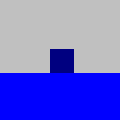|
CGAL 4.9.1 - Inscribed Areas
|
|
CGAL 4.9.1 - Inscribed Areas
|

The optimization code uses infix OPTIMISATION in the assertions, e.g. defining the compiler flag CGAL_OPTIMISATION_NO_PRECONDITIONS switches precondition checking off, cf. Section Checks.
CGAL::maximum_area_inscribed_k_gon_2CGAL::maximum_perimeter_inscribed_k_gon_2CGAL::extremal_polygon_2CGAL::Largest_empty_iso_rectangle_2<T>CGAL::Extremal_polygon_area_traits_2<K>CGAL::Extremal_polygon_perimeter_traits_2<K>ExtremalPolygonTraits_2LargestEmptyIsoRectangleTraits_2 Modules | |
| Concepts | |
Classes | |
| class | CGAL::Extremal_polygon_area_traits_2< K > |
| This is an advanced class. More... | |
| class | CGAL::Extremal_polygon_perimeter_traits_2< K > |
| This is an advanced class. More... | |
| class | CGAL::Largest_empty_iso_rectangle_2< T > |
Given a set of points in the plane, the class Largest_empty_iso_rectangle_2 is a data structure that maintains an iso-rectangle with the largest area among all iso-rectangles that are inside a given bounding box( iso-rectangle), and that do not contain any point of the point set. More... | |
Functions | |
| template<class RandomAccessIterator , class OutputIterator , class Traits > | |
| OutputIterator | CGAL::extremal_polygon_2 (RandomAccessIterator points_begin, RandomAccessIterator points_end, int k, OutputIterator o, const Traits &t) |
computes a maximal (as specified by t) inscribed k-gon of the convex polygon described by [points_begin, points_end), writes its vertices to o and returns the past-the-end iterator of this sequence. More... | |
| template<class RandomAccessIterator , class OutputIterator > | |
| OutputIterator | CGAL::maximum_area_inscribed_k_gon_2 (RandomAccessIterator points_begin, RandomAccessIterator points_end, int k, OutputIterator o) |
computes a maximum area inscribed k-gon of the convex polygon described by [points_begin, points_end), writes its vertices to o and returns the past-the-end iterator of this sequence. More... | |
| template<class RandomAccessIterator , class OutputIterator > | |
| OutputIterator | CGAL::maximum_perimeter_inscribed_k_gon_2 (RandomAccessIterator points_begin, RandomAccessIterator points_end, int k, OutputIterator o) |
computes a maximum perimeter inscribed k-gon of the convex polygon described by [points_begin, points_end), writes its vertices to o and returns the past-the-end iterator of this sequence. More... | |
| OutputIterator CGAL::extremal_polygon_2 | ( | RandomAccessIterator | points_begin, |
| RandomAccessIterator | points_end, | ||
| int | k, | ||
| OutputIterator | o, | ||
| const Traits & | t | ||
| ) |
computes a maximal (as specified by t) inscribed k-gon of the convex polygon described by [points_begin, points_end), writes its vertices to o and returns the past-the-end iterator of this sequence.
The function extremal_polygon_2() computes a maximal k-gon that can be inscribed into a given convex polygon. The criterion for maximality and some basic operations have to be specified in an appropriate traits class parameter.
[points_begin, points_end) form the boundary of a convex polygon (oriented clock- or counterclockwise). k >= t.min_k().| Traits | must be a model for ExtremalPolygonTraits_2. |
| RandomAccessIterator | must be an iterator with value type Traits::Point_2. |
| OutputIterator | must accepts dereference/assignments of Traits::Point_2. |
CGAL::maximum_area_inscribed_k_gon_2() CGAL::maximum_perimeter_inscribed_k_gon_2() ExtremalPolygonTraits_2Implementation
The implementation uses monotone matrix search [1] and has a worst case running time of \( O(k \cdot n + n \cdot \log n)\), where \( n\) is the number of vertices in \( P\).
#include <CGAL/extremal_polygon_2.h>
| OutputIterator CGAL::maximum_area_inscribed_k_gon_2 | ( | RandomAccessIterator | points_begin, |
| RandomAccessIterator | points_end, | ||
| int | k, | ||
| OutputIterator | o | ||
| ) |
computes a maximum area inscribed k-gon of the convex polygon described by [points_begin, points_end), writes its vertices to o and returns the past-the-end iterator of this sequence.
Computes a maximum area k-gon \( P_k\) that can be inscribed into a given convex polygon \( P\). Note that
k-gon, where the k vertices are to be drawn from a planar point set \( S\), lie on the convex hull of \( S\) i.e. a convex polygon. [points_begin, points_end) form the boundary of a convex polygon (oriented clock- or counterclockwise). k >= 3.| RandomAccessIterator | must be an iterator with value type K::Point_2 where K is a model of Kernel. |
| OutputIterator | must accepts dereference/assignments of Traits::Point_2. |
CGAL::maximum_perimeter_inscribed_k_gon_2() ExtremalPolygonTraits_2 CGAL::Extremal_polygon_area_traits_2<K> CGAL::Extremal_polygon_perimeter_traits_2<K> CGAL::extremal_polygon_2()Implementation
The implementation uses monotone matrix search [1] and has a worst case running time of \( O(k \cdot n + n \cdot \log n)\), where \( n\) is the number of vertices in \( P\).
Example
The following code generates a random convex polygon p with ten vertices and computes the maximum area inscribed five-gon of p.
File Inscribed_areas/extremal_polygon_2_area.cpp
#include <CGAL/extremal_polygon_2.h>
| OutputIterator CGAL::maximum_perimeter_inscribed_k_gon_2 | ( | RandomAccessIterator | points_begin, |
| RandomAccessIterator | points_end, | ||
| int | k, | ||
| OutputIterator | o | ||
| ) |
computes a maximum perimeter inscribed k-gon of the convex polygon described by [points_begin, points_end), writes its vertices to o and returns the past-the-end iterator of this sequence.
The function maximum_perimeter_inscribed_k_gon_2() computes a maximum perimeter k-gon \( P_k\) that can be inscribed into a given convex polygon \( P\). Note that
k-gon, where the k vertices are to be drawn from a planar point set \( S\), lie on the convex hull of \( S\) i.e. a convex polygon. [points_begin, points_end) form the boundary of a convex polygon (oriented clock- or counterclockwise). k >= 2.| RandomAccessIterator | must be an iterator with value type K::Point_2 where K is a model for Kernel. |
| OutputIterator | must accepts dereference/assignments of Traits::Point_2. |
There must be a global function K::FT CGAL::sqrt(K::FT) defined that computes the squareroot of a number.
CGAL::maximum_area_inscribed_k_gon_2() ExtremalPolygonTraits_2 CGAL::Extremal_polygon_area_traits_2<K> CGAL::Extremal_polygon_perimeter_traits_2<K> CGAL::extremal_polygon_2()Implementation
The implementation uses monotone matrix search [1] and has a worst case running time of \( O(k \cdot n + n \cdot \log n)\), where \( n\) is the number of vertices in \( P\).
Example
The following code generates a random convex polygon p with ten vertices and computes the maximum perimeter inscribed five-gon of p.
File Inscribed_areas/extremal_polygon_2_perimeter.cpp
#include <CGAL/extremal_polygon_2.h>